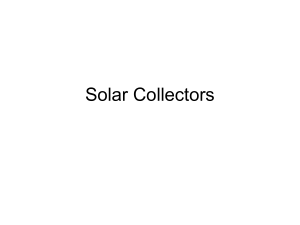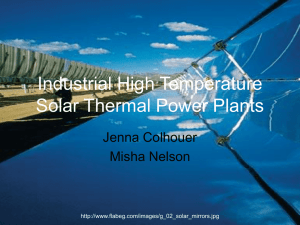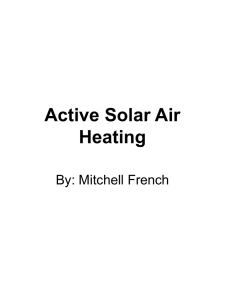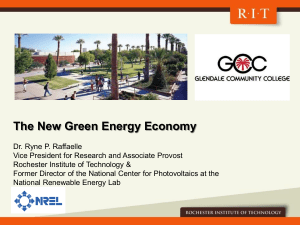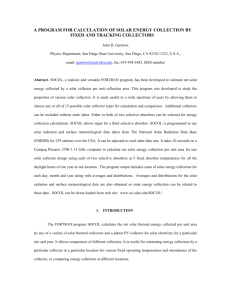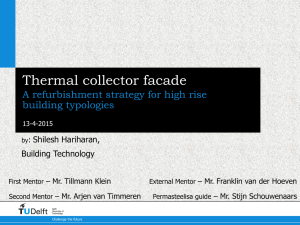Slide PPT
advertisement
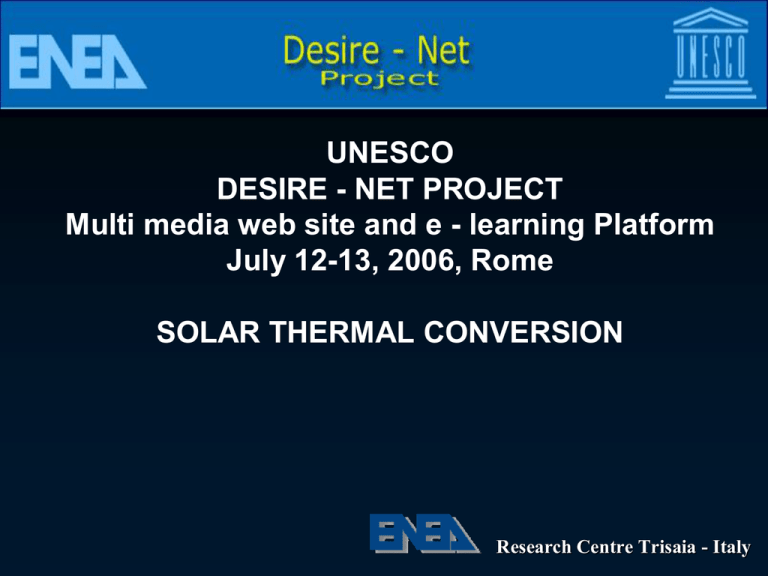
UNESCO DESIRE - NET PROJECT Multi media web site and e - learning Platform July 12-13, 2006, Rome SOLAR THERMAL CONVERSION Research Centre Trisaia - Italy TRADITIONAL CLASSIFICATION OF RENEWABLES INDIRECT DIRECT SOLAR THERMAL LOW TEMP. (< 100 °C) SOLAR PV MED. TEMP. (100 °C – 300 °C) WIND HYDRO BIOMASS OTHERS HIGH TEMP. THERMO BIO (> 300 °C) CHEMICAL CHEMICAL With the exception of nuclear, geothermal and tidal energy, all forms of of energy used on earth originate from the sun’s energy. The flow of renewable solar energies on earth is essentially equal to the flow of energy due to solar radiation. Every year, the sun irradiates the earth's land masses with the equivalent of 19 trillion toe. A fraction of this energy could satisfy the world's energy requirements, around 9 billion toe per year. The use of energy in the form of heat is one of the largest items in the energy budget.In Europe, for instance, it accounts for around 50% of total energy consumption: around 630 million toe, of which 383 in lowtemperature heat and 247 in medium- and high-temperature heat. Today, low-temperature (<100oC) thermal solar technologies are reliable and mature for the market. World-wide, they help to meet heating needs with the installation of several million square metres of solar collectors per year. These technologies can play a very important role in advanced energy-saving projects, especially in new buildings and structures. SOLAR THERMAL The thermal conversion of solar energy is usually classified according to the temperatures required (low, medium and high temperature ranges) but it can also be classified according to the specific use of the collected energy (water heating, space heating, process heat, etc.). The modern Active Solar Systems market began as a consequence of the oil crisis in the 1970’s. Many companies were created World-wide to manufacture, sell and install a series of new products, principally for heating water in private houses, public buildings and swimming pools. This enthusiastic and dynamic commercial activity was backed up by government sponsored research and development projects. Great hopes were built on a steadily growing market. However, by the mid-1980s the situation changed, oil prices started to fall and the public fear of a conventional energy shortage slowly died out. The solar industry suffered badly and the majority of the newly formed companies disappeared. Those that manage to survive improved their products, re-organised production methods and introduced quality controls in order to satisfy more exacting customer demands. The market has stabilised, but in most European countries the stabilisation is at a rather low level. Solar radiation: Some data Surafce temperaure = 5780°C Expression for surface temperature T = (r2S/R2σ )1/4 Solar constant: 1367 W/m² Solar constant : is defined as the amount of radiant energy received per second by a unit area of a perfectly black body surface field at right angle to the direction of the sun rays at the mean distance of the earth from the sun. Average distance between sun and earth = 149.5 106 km Solar radiation on the surface comprises of : Direct radiation: The solar radiation that reaches the surface of the earth without being diffused is called direct beam solar radiation. Diffused radiation: As sunlight passes through the atmosphere, some of it is absorbed, scattered, and reflected by air molecules, water vapour, clouds, dust, and pollutants from power plants, forest fires, and volcanoes. This is called diffuse solar radiation. Global solar radiation: The sum of the diffuse and direct solar radiation is called global solar radiation. Distribution of solar radiation, in Italy Daily solar radiation monthly average (MJ/m²) February July Components of a glazed collector ABSORBER PLATE (1) • copper and fins enhance heat transfer • high absorptance and low emissivity thanks to a selective paint • includes the TUBING GRID (2) and the PIPING CONNECTION (3) TRANSPARENT COVERING (5) • typically a relatively thick glass with high solar transmittance • designed to reduce reflection • tempered to maximise strength and durability THERMAL INSULATION (6) • polyurethane foam or mineral wool • surrounding the absorber heat losses from the carrier fluid • an attached ALUMINUM FOIL (4) acts as a barrier against outgassing CASING (7) • plastic or aluminium • ensures strength and resistance to the atmospheric agents • equipped for roof integration or anchorage to the roof or stand • differential expansion of frame and glazing is absorbed by GASKETS (8) • the whole is closed by a BACK PLATE (9) usually made of PVC Solar collectors The conventional collector is the core element of a solar system for DHW or space heating Low temperature panels supply the carrier fluid at a temperature usually lesser than 80 °C Differently from concentrating collectors, conventional solar panels work with both direct and diffused irradiation, thus producing hot water in cloudy days also Two large families: Unglazed collectors Glazed collectors Unglazed collectors Working principle: the water, flowing into the panels tubes, is instantly heated by the sunbeams and then sent to a storage tank or even directly to the final user low cost easy to install surrounding air temperature > 20 °C required temperature for water < 50 °C summer uses (camping, hotels, swimming pool, etc.) Glazed collector basic principle A glazed collector acts basically as a greenhouse: Covering The incident solar radiation is for the most part transmitted through the cover (the transmittance of a single glass cover is over 90%) and then trapped by the absorber. The absorber plate warms up and emits in its turn radiant energy, but in the infrared spectrum, regarding which glass proves to be nearly opaque (greenhouse effect). Absorber Glazed collectors Working principle: the panels tubes, in which the carrier fluid flows, are in this case protected by a single or multiple transparent covering, made of glass or plastic, thus improving the performances thanks to the greenhouse effect Most common type: flat plate collector Tubular collectors An advanced type of glazed collector: tubular collector In this type of collector, the absorber strip is located in a pressure proof glass tube. The heat transfer fluid flows through the absorber directly in a U-tube or in counter-current in a tube-in-tube system. In case superior performances are required, the air, between the glass tube and the absorber inside it, is aspirated (evacuated tubular collector). Energy losses in a glazed collector Energy supplied to the fluid Solar irradiation on collector area Thermal loss Optical loss • given by (1 - ) • possible reduction is limited • at least 1520% for a flat plate glazed collector • roughly proportional to T typically when T is around 80 °C thermal loss is equal to absorbed irradiation (stagnation point) • increases dramatically when difference in temperature is high • explains the use of ETC in severe climates Collector efficiency curve Thermal performance of a solar collector is represented by means of a curve (or a simple straight line) which expresses the efficiency as a function of the reduced temperature. 1 0 U c Efficiency (%) 0.8 (Tm Ta ) G (T T ) (T T ) 0 a1 m a a2G0 m a G G 0.6 2 Evacuated tubular collector Uc = 2 (W/m²)/K 0.4 Unglazed collector Uc = 20 (W/m²)/K Glazed flat plate collector Uc = 5 (W/m²)/K (selective) Uc = 7 (W/m²)/K (not selective) 0.2 0 0 0.01 0.02 0.03 0.04 0.05 0.06 0.07 T* = (Tm-Ta)/G [m²K/W] 0.08 0.09 0.1 Open and closed loop systems Open loop system for non-freezing warm climates (danger of freezing is not present (Greece, Israel) Closed loop systems for continental climates (from Italy going to North: Carrier fluid in the collectors is the same of the user an anti-freeze solution is added to the carrier fluid which is different from the one that goes to the consumer Simplicity and economy system's advantages. are this Greater efficiency because there is not the additional loss due to heat exchanger Greater cost and volume no build-up of scaling in the collector. Solar systems families: Factory Made Solar systems can be divided into 2 main categories: “Factory Made” Systems Pre-assembled by the manufacturer Natural circulation (thermosyphon) Single family Total area typically 4 m² Thermosyphon systems circulation of the carrier fluid is provided solely by the heating of the same, which implies a reduction in its density thus generating a convective flow towards the top (passive systems with no moving parts) natural circulation of the carrier fluid must be facilitate by placing the storage tank in a higher position than the collector are usually characterised by a limited size (2 - 4 m²) and commercialised as "factory made" systems generally back-up is electric and integrated in the storage tank HOT COLD Integrated Collector Storage The ICS system, also called batch water heater, is a not much widespread type of passive system. The water is produced and stored inside the collector. suitable only for mild climates where there is no risk of freezing efficient heat transfer to the water superior simplicity, compactness, and economics unfavourable heat loss coefficient profitable storage only in the very short term typically used as a pre-heater to an existing gas or electric water heater main remarks Components of a plant A plant for low temperature heat application using solar energy is comprises of: 1) system for collection and transfomation of energy 2) Storage tank 3) Hydraulic circuit 4) System for integration shower Mixer cold water 70 °C Flat plate or evacuated tubular collectors Auxilliary heater Differential exchange of control and regulation 20 °C Thermosyphon Radiator Heat exchanger Stratified distributor Forced circulation systems circulation of the carrier fluid is provided through a pump run by a differential thermostat when T between the fluid out from the collectors and the water in the tank is 510 °C are mostly utilised when positioning of the tank over collectors is not possible or length of the piping excessive for achieving natural circulation of carrier fluid the the the is a the normally are intended for multi-family houses and commercialised as "custom built" systems the back-up can be a gas or oil heater with an additional tank in series 1. Collector - 2. Storage Tank - 3. Heat exchanger - 4. Control Unit - 5. Expansion Vessel - 6. Backup Heater - 7. User Solar systems families: Custom Built “Custom Built” Systems Assembled with properly chosen components Forced circulation (pumped) Collective users Total area usually > 10 m² Description: Roof integrated flat plate collectors on house in Germany Description: Roof integrated flat plate collectors on house in Germany Description: Roof integrated flat plate collectors Source: VELUX / ESTIF Description: Roof integrated flat plate collectors on house in Germany Source: Ritter Solar / ESTIF Description: Hotel in Austria Source: Solution Solartechnik / Austria Solar Description: Hotel in Austria Source: Sonnenkraft / Austria Solar Description: Hotel in Austria Source: Gasokol / Austria Solar Description: School in Ireland Source: Thermomax / ESTIF Description: Collectors for DHW in University Description: School in Skive, Denmark Description: Hospital in Rome

